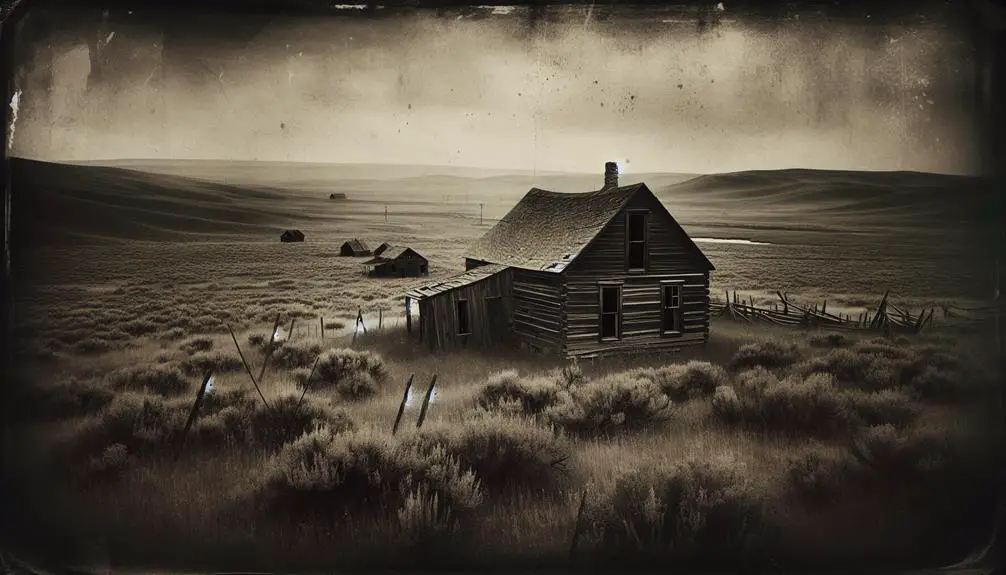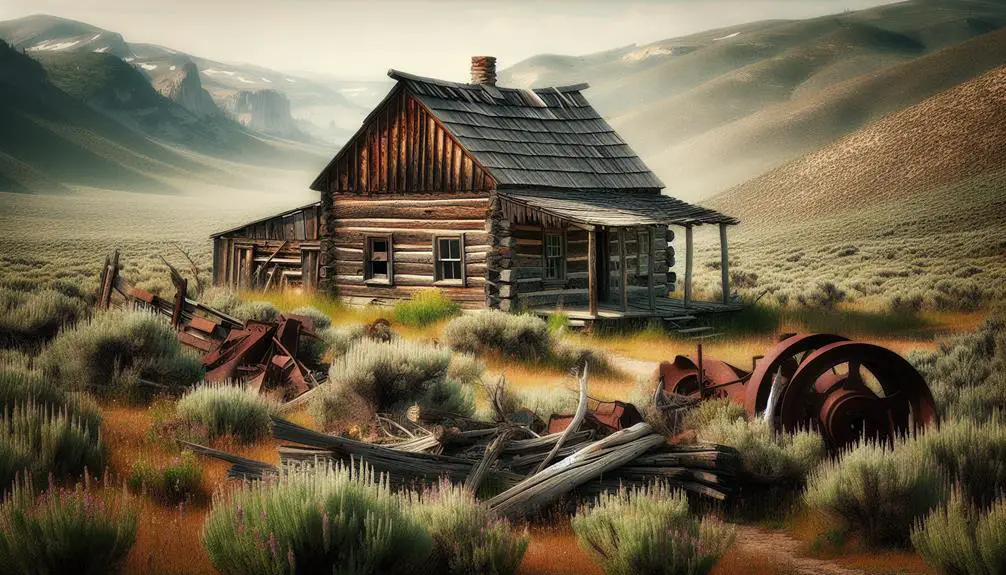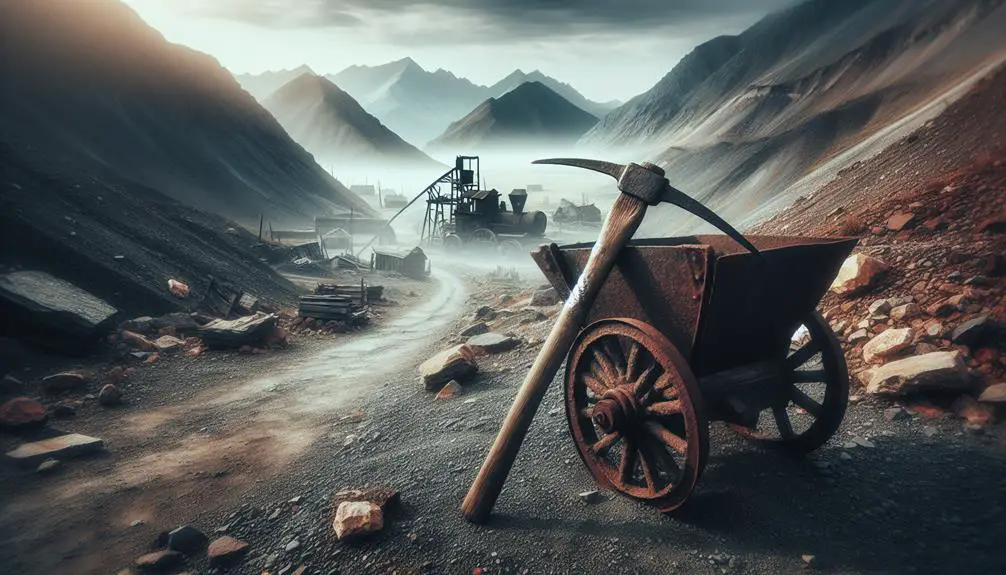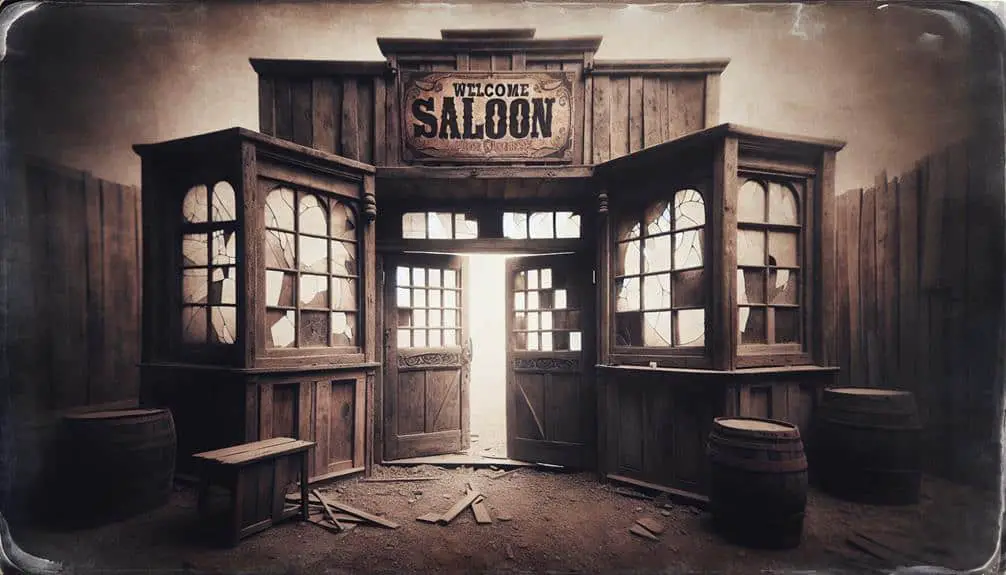Eerie traces from frontier communities linger, revealing ghostly remnants of the past. Abandoned structures stand as silent witnesses to stories left untold. Crumbling walls whisper of a once vibrant community frozen in time. Haunting graveyards bear the weight of forgotten lives, with weathered tombstones echoing history. Rusting artifacts speak of toil and challenges faced in a harsh frontier existence. Empty streets carry echoes of long-gone laughter, intertwined with a melancholy sense of what once was. Faded signs point to lost prosperity and vanished memories. These traces offer a glimpse into the haunting beauty of forgotten frontiers.
Key Points
- Weathered tombstones with fading inscriptions reveal forgotten lives.
- Abandoned structures hold ghostly remnants of a bustling past.
- Haunting spirits linger in the desolate atmosphere of frontier communities.
- Eerie traces of bygone eras stir reverence for the transient nature of existence.
- Rusting artifacts silently speak of toil, innovation, and challenges of frontier life.
Abandoned Structures Whisper Forgotten Stories
Have you ever wondered what tales lie hidden within the decaying walls of abandoned structures? These mysterious ruins hold ghostly remnants of the past, whispering forgotten stories of frontier communities long gone. As you explore these desolate places, you may feel a sense of curiosity tinged with a hint of trepidation, unsure of what you might uncover.
The crumbling walls and creaking floorboards of these abandoned structures serve as silent witnesses to the passage of time. Peering through shattered windows, you catch glimpses of a world frozen in a bygone era, where life once thrived but now only echoes remain. The faded paint and weathered wood tell a story of resilience and decay, painting a picture of a once vibrant community now lost to the ages.
Each room you step into is filled with a sense of mystery and intrigue, as if the walls themselves are trying to communicate with you. The ghostly remnants of the past linger in the air, leaving you haunted by the memories of those who once called these places home.
Haunting Graveyards Mark Forgotten Lives
Exploring the eerie traces of frontier communities, one encounters haunting graveyards that solemnly mark the forgotten lives of those who once populated these desolate landscapes. These burial grounds serve as poignant reminders of the individuals who've long since passed, their forgotten memories lingering in the air like whispers of the past. As you walk among the weathered tombstones, you can sense the weight of history pressing down, each remembrance to a life once lived.
The atmosphere in these graveyards is thick with the presence of haunting spirits, their stories etched into the very fabric of the land. The wind carries echoes of bygone eras, stirring the imagination and invoking a sense of reverence for those who came before. It's a humbling experience, standing amidst the silent sentinels of the deceased, contemplating the mysteries of life and death.
These forgotten lives, preserved in stone and earth, beckon you to reflect on the transient nature of existence. The graveyards of frontier communities aren't just resting places for the deceased but also repositories of history, where the past and present converge in a timeless dance of remembrance.
Rusting Artifacts Tell Tales of the Past
Rusting artifacts scattered throughout frontier landscapes vividly recount the stories of the past, revealing glimpses of bygone eras through their silent decay. These remnants, once essential tools or structures, now stand as silent witnesses to the lives led in these rugged terrains. Each weathered piece, whether a rusted plow left in a field or a dilapidated mining cart abandoned near a shaft, speaks of the toil, innovation, and challenges faced by those who settled these lands.
The rusting artifacts serve as decaying memories, capturing moments frozen in time, offering a window into the past for those willing to listen. The corroded surfaces and twisted metal tell tales of perseverance, struggle, and ingenuity, mirroring the harsh realities of frontier life. As you walk among these relics, you can almost hear the echoes of hard work and determination that once filled these now desolate landscapes.
These artifacts not only preserve history but also prompt reflection on the resilience of those who ventured into the unknown, seeking a better future amidst the rugged beauty of the frontier.
Empty Streets Echo Long-Gone Laughter
As you traverse these abandoned frontier landscapes, the silence of empty streets now stands as a poignant reminder of long-gone laughter that once filled these thoroughfares. The ghostly shadows of former residents seem to linger, their presence almost palpable in the stillness that envelops these forgotten towns. Each step you take echoes through the vacant buildings, reverberating against the walls that once bore witness to bustling activity and joyous moments.
Amidst the eerie footsteps of the past, a sense of nostalgia hangs heavy in the air, intertwining with the melancholy of what once was. The laughter that once danced through these streets now only whispers in the wind, a faint echo of happier times. It's as if the essence of those who once called this place home still lingers, their memories etched into the very fabric of the abandoned structures.
These empty streets offer a glimpse into a world long past, where the laughter of children and the chatter of neighbors filled the air. Now, all that remains are the echoes of a bygone era, haunting reminders of the vibrant community that once thrived here.
Faded Signs Point to Lost Prosperity
Faint remnants of once vibrant businesses now serve as faded signs pointing to lost prosperity in these deserted frontier communities. As you walk down the empty streets, you can't help but notice the ghostly remnants of what used to be bustling shops and lively establishments. These remnants of the past are like vanishing memories, whispering stories of a time when these streets were filled with laughter and commerce.
The cracked facades of abandoned stores and weather-worn signs are the vestiges of a bygone era, a stark reminder of the lost prosperity that once thrived in these now desolate areas. Each peeling paint and shattered window tells a tale of economic decline and a community left behind.
Despite the eerie silence that now envelops these streets, the faded signs of businesses long gone continue to stand as tokens to the resilience and struggles of frontier communities. These whispers of history serve as a poignant reminder of the transient nature of prosperity and the inevitable changes that shape the landscapes of our past.
Frequently Asked Questions
How Did Frontier Communities Handle Communication and Transportation in Their Isolated Environments?
In the isolated frontier, communication methods were inventive, from smoke signals to messengers covering vast distances. Despite transportation challenges like rugged terrain, communities thrived by adapting, proving the adage true: "Where there's a will, there's a way."
What Role Did Religion Play in the Lives of Individuals Living in Frontier Communities?
Religious practices shaped daily life in frontier communities, fostering community bonds through shared beliefs and rituals. Individuals found solace, guidance, and strength in their faith, creating a sense of unity and purpose in their isolated existence.
Were There Any Notable Conflicts or Disputes Within Frontier Communities That Have Left Lasting Impacts?
Notable conflicts within frontier communities often stemmed from land disputes and community rivalries, leading to lasting impacts on social dynamics and local history. Understanding these disputes sheds light on the complexities of frontier life.
How Did Frontier Communities Interact With Indigenous Populations in the Surrounding Areas?
In frontier communities, cultural exchange with indigenous populations was essential for survival. Resource sharing created bonds, fostering understanding and cooperation. Despite challenges, mutual respect and collaboration often led to peaceful coexistence and enriched both groups' lives.
What Were Some Common Occupations or Industries That Sustained Frontier Communities Before Their Decline?
Before their decline, frontier communities sustained themselves through diverse occupations and industries. Agricultural practices, trade networks, mining operations, and the logging industry were common sources of livelihood, supporting the community's growth and prosperity.



